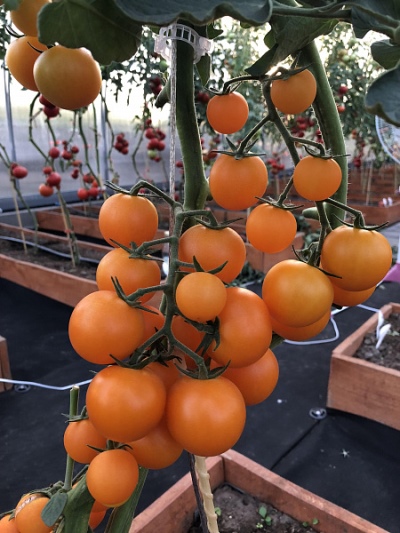
- Authors: Blokin-Mechtalin V.I.
- Year of approval: 2020
- Category: hybrid
- Growth type: indeterminate
- Appointment: fresh consumption
- Ripening period: early
- Ripening time, days: 90-95
- Growing conditions: for open ground, for film greenhouses, for greenhouses
- Transportability: good
- Bush height, cm: 180-220
Tomato Zlatoyar - such an "old Russian" name should not be misleading. This is one of the newest Russian selection of tomatoes. And therefore, it should be given serious attention.
Breeding history
The creator of the plant is the famous breeder Blokin-Mechtalin. The official permission for the cultivation of crops for consumer purposes was given in 2020. It must be borne in mind that this is a hybrid variety. It is known that the selection resources of the partner agrofirm were used to obtain the tomato.
Description of the variety
Indeterminate hybrids, including Zlatoyar, are popular with many gardeners. The plant is recommended for open ground and for film greenhouses. But in traditional greenhouses, it can also be grown without problems. Most often, the harvested crop is eaten immediately, fresh. Bushes can grow up to 1.8-2.2 m. The foliage reaches an average length. A simple green color is typical for her.
The main qualities of the fruit
The color of the unripe fruit is light green, while the ripe fruit is orange. Ribbing is not clearly expressed. The size of each fruit is 40-50 grams.
Taste characteristics
The Zlatoyar tomato is praised for its very pleasant sweetness. It is very well expressed. The firmness and firmness of the pulp is noted. The skin of the fruit is quite elastic.
Ripening and fruiting
The Zlatoyar tomato is one of the early garden crops. Between discarding green shoots and readiness to harvest, an average of 90-95 days pass. You can shoot berries in July and August. However, meteorological conditions in a number of situations make amendments to this generally accepted schedule.
Yield
The number of berries is quite impressive. It can reach 15 kg per 1 m2. But such a result is obtained only with impeccably correct agricultural technology and a competent choice of a site. Transporting the harvested fruits will not be difficult.
The timing of planting seedlings and planting in the ground
You need to prepare containers, soil and seeds for planting by March. If the seedlings develop normally after this, the time to transplant to open areas comes in May. It is necessary to be guided not so much by formal terms, however, as by the real readiness of the plants themselves.

Growing tomato seedlings is an extremely important process, because it largely depends on whether the gardener can harvest at all. All aspects must be taken into account, from seedbed preparation to planting in the ground.
Landing scheme
3 or 4 plants are placed on 1 "square". The choice between these density options is, as always, determined by personal gardening priorities. The location of the holes is recommended according to the rule of 500x500 mm. Tomatoes should be shaped into 1 or 2 stems.

Growing and care
It is impossible to do without a systematic formation. Due to the youth of the variety, other recommendations for its cultivation are still poorly developed. At the stage of seedling preparation, you will have to help the development of the roots, but at the same time exclude premature flowering. Picks are carried out as you grow. In winter, illumination is necessary, and before planting in open ground, hardening. Crop care in soil beds is the same as for other early maturing indeterminate hybrids.




A plant needs different micronutrients at each stage of growth. All fertilizers can be divided into two groups: mineral and organic. Folk remedies are often used: iodine, yeast, bird droppings, eggshells.
It is important to observe the rate and period of feeding. This also applies to folk remedies and organic fertilizers.
Disease and pest resistance
The variety can successfully survive exposure to:
fusarium wilting;
tobacco mosaic;
cladosporiosis;
verticillosis.
Fruit cracking is also not very typical for such a crop. But this does not mean that the need for protective treatments can be ignored. Since recommendations for protection for this particular variety have not yet been developed, you can follow the instructions for the drugs used.


Growing regions
Zlatoyar will equally delight the farmers of the North of Russia, the Moscow region and the North Caucasus. It can also be advised to summer residents of the Leningrad, Tver regions, as well as Karelia. This culture is able to give excellent results in the Volga and Ural regions. On the territory of Western and Eastern Siberia, the result will be slightly worse, but still the variety deserves attention. It is also worth emphasizing the suitability for the Far East and the Black Earth Region.

























































































